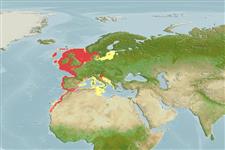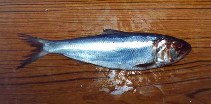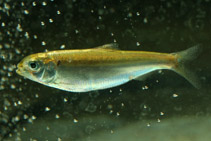把你的觀察加入 Fish Watcher
| Native range | All suitable habitat | Point map | Year 2050 |

|
| This map was computer-generated and has not yet been reviewed. |
| Alosa alosa AquaMaps Data sources: GBIF OBIS |
Portugal country information
Common names:
Sável, Sável
Occurrence: native
Salinity: freshwater
Abundance: | Ref:
Importance: commercial | Ref: Antunes, C., F. Cobo and M.J. Araujo, 2016
Aquaculture: | Ref:
Regulations: | Ref:
Uses: live export: yes;
Comments: Known from the Atlantic coast (Ref. 59043). Found in the Iberian Peninsula (Ref. 119049). Recorded from Lima River (Ref. 12507). Minimum capture size: 35-50 cm TL (Ref. 119049). Also Ref. 188, 11237, 11601, 12255, 59043. Status of threat: Endangered (Ref. 119049).
National Checklist: Portugal
Country Information: https://www.cia.gov/library/publications/resources/the-world-factbook/geos/po.html
National Fisheries Authority:
Occurrences: Occurrences Point map
Main Ref: Almaça, C., 1995
National Database: Portuguese Freshwater Fishes
Occurrence: native
Salinity: freshwater
Abundance: | Ref:
Importance: commercial | Ref: Antunes, C., F. Cobo and M.J. Araujo, 2016
Aquaculture: | Ref:
Regulations: | Ref:
Uses: live export: yes;
Comments: Known from the Atlantic coast (Ref. 59043). Found in the Iberian Peninsula (Ref. 119049). Recorded from Lima River (Ref. 12507). Minimum capture size: 35-50 cm TL (Ref. 119049). Also Ref. 188, 11237, 11601, 12255, 59043. Status of threat: Endangered (Ref. 119049).
National Checklist: Portugal
Country Information: https://www.cia.gov/library/publications/resources/the-world-factbook/geos/po.html
National Fisheries Authority:
Occurrences: Occurrences Point map
Main Ref: Almaça, C., 1995
National Database: Portuguese Freshwater Fishes
Common names from other countries
分類 / Names 俗名 | 同種異名 | Catalog of Fishes(屬, 種) | ITIS | CoL | WoRMS | Cloffa
Teleostei > Clupeiformes (Herrings) > Alosidae (Shads and Sardines)
Etymology: Alosa: Latin, alausa = a fish cited by Ausonius and Latin, halec = pickle, dealing with the Greek word hals = salt; it is also the old Saxon name for shad = "alli" ; 1591 (Ref. 45335).
More on author: Linnaeus.
Etymology: Alosa: Latin, alausa = a fish cited by Ausonius and Latin, halec = pickle, dealing with the Greek word hals = salt; it is also the old Saxon name for shad = "alli" ; 1591 (Ref. 45335).
More on author: Linnaeus.
Environment: milieu / climate zone / depth range / distribution range 生態學
分布 國家 | FAO區域 | 生態系 | 發現紀錄 | Point map | 簡介 | Faunafri
Eastern Atlantic: from southern Norway and along the coasts of Europe to northern Mauritania (Ref. 188, 6683), including the Western Baltic Sea up to the Kaliningrad Oblast (Ref. 12801, 26334, 59043), the western part of Mediterranean Sea (Ref. 188, 6683, 59043) and the coasts of northern Africa (Ref. 3509). However, presently only very locally distributed outside France, victim of pollution and impoundment of large rivers throughout Europe (Ref. 59043).
東大西洋: 從卑爾根 (挪威) 沿著對在非洲中的茅利塔尼亞北部的歐洲的海岸。 (參考文獻 188, 參考文獻 51442) 也在地中海的西部中.(參考文獻 188) 記錄來自了波羅的海西部海洋向上到加里寧格勒州.(參考文獻 12801,26334) 伯恩公約的附錄 3(受保育的動物群).
東大西洋: 從卑爾根 (挪威) 沿著對在非洲中的茅利塔尼亞北部的歐洲的海岸。 (參考文獻 188, 參考文獻 51442) 也在地中海的西部中.(參考文獻 188) 記錄來自了波羅的海西部海洋向上到加里寧格勒州.(參考文獻 12801,26334) 伯恩公約的附錄 3(受保育的動物群).
Length at first maturity / 大小 / 重量 / 年齡
Maturity: Lm 47.8, range 45 - 50 cm
Max length : 69.0 cm TL 雄魚/尚未辨別雌雄; (Ref. 10536); 83.0 cm TL (female); common length : 40.0 cm TL 雄魚/尚未辨別雌雄; (Ref. 2945); common length :70 cm TL (female); 最大體重: 4.0 kg (Ref. 30578); 最大年齡: 10 年 (Ref. 10536)
Max length : 69.0 cm TL 雄魚/尚未辨別雌雄; (Ref. 10536); 83.0 cm TL (female); common length : 40.0 cm TL 雄魚/尚未辨別雌雄; (Ref. 2945); common length :70 cm TL (female); 最大體重: 4.0 kg (Ref. 30578); 最大年齡: 10 年 (Ref. 10536)
簡短描述 檢索表 | 型態特徵 | 形態測量圖
背棘 (總數) : 0; 背的軟條 (總數) : 18 - 21; 臀棘: 0; 臀鰭軟條: 20 - 27; 脊椎骨: 57 - 58. Diagnosis: Body somewhat compressed, fairly deep with depth at pectoral fin more than head length, scutes apparent along belly (Ref. 188, 51442). Upper jaw with a distinct median notch, lower jaw fitting into it; no teeth on palatine and vomer; gillrakers long, thin and numerous, a total of 85 to 155 on first arch, longer than gill filaments (Ref. 188, 6683, 59043). A dark spot posterior to gill opening, but sometimes absent, sometimes followed by several small blotches (Ref. 188, 59043). Alosa alosa resembles Alosa fallax, which has fewer and shorter gillrakers and 7 or 8 black spots along flank (Ref. 188).
身體略微扁長形的, 相當深的在胸鰭超過頭長隨著深度.(參考文獻 188, 參考文獻 51442) 上頜凹槽, 下頜嵌入它。 (參考文獻 188) 鰓耙長的﹐細的與很多的, 總計 85 到 130, 長度超過鰓絲.(參考文獻 188) 大又細的鱗片.(參考文獻 51442) 出現腹部的鱗甲。 (參考文獻 51442) 一個深色斑點在鰓裂後面 (有時不存在; 偶然地 1 或 2 更多的斑點).(參考文獻 188)
身體略微扁長形的, 相當深的在胸鰭超過頭長隨著深度.(參考文獻 188, 參考文獻 51442) 上頜凹槽, 下頜嵌入它。 (參考文獻 188) 鰓耙長的﹐細的與很多的, 總計 85 到 130, 長度超過鰓絲.(參考文獻 188) 大又細的鱗片.(參考文獻 51442) 出現腹部的鱗甲。 (參考文獻 51442) 一個深色斑點在鰓裂後面 (有時不存在; 偶然地 1 或 2 更多的斑點).(參考文獻 188)
Amphihaline species, schooling and strongly migratory, penetrating far up rivers but not into small tributaries (Refs. 188, 59043). Adults are usually found in open waters along the coast (Ref. 51442). In freshwater, inhabits major rivers but may also enter tributaries, if water temperature is equal to or is warmer than the main river (Ref. 188, 10536). Known lake populations from Morocco and Portugal need access to rivers to spawn (Refs. 10536, 89647, 89648). Larvae and small juveniles inhabit deep slow-flowing areas of rivers (Ref. 89649), some swimming upstream in late summer and autumn (Ref. 10536). Juveniles (up to 1+ years) are usually found near estuaries or river mouths (Refs. 10536, 59043), possibly making vertical diurnal movements synchronized with the tides; they remain in estuaries for over one year (Ref. 89630). Feeds on a wide range of planktonic crustaceans; larger adults feed on small schooling fishes (Ref. 188, 51442, 59043). Juveniles in freshwater prey on insect larvae. Females in European rivers commonly reach 70 cm total length (Ref. 10536). Females grow faster and are always larger than males of the same age (Ref. 10536). Less common than Alosa fallax but both have suffered from pollution and weirs or other obstructions (Ref. 188). It has been suggested that members of the genus Alosa are hearing specialists with the American shad (Alosa sapidissima) having been found to detect and respond to sounds up to at least 180 kHz (Ref. 89631). This may aid in predator avoidance (e.g. cetaceans) (Ref. 89632). Hybridization with the twaite shad (Alosa fallax) has been reported from the Rhine (Ref. 89633) as well as from rivers in France and Algeria (Ref. 10536). Shad hybrids may reproduce (Ref. 27567). Marketed fresh and frozen; eaten sautéed, broiled, fried and baked (Ref. 9988).
Amphihaline 種, 在海洋中度過它大部分的生活期.(參考文獻 51442) 群游性而強烈的迴游性種, 穿透在河川最上游, 但是不進入小的支流之內.(參考文獻 188) 五月時進入河中產卵, 通常在晚上與水流是迅急的地方.(參考文獻 188) 迴游成魚不進食。 (參考文獻 30578) 成魚在產卵此時稚魚之後返回大海移動秋天時向下至海洋.(參考文獻 188) 吃寬範圍的浮游性甲殼動物; 較大的成魚吃小的群游性魚。 (參考文獻 188, 參考文獻 51442) 比 Alosa fallax不普遍但是兩者已經蒙受污染與魚樑或其他的障礙.(參考文獻 188) 在市場上銷售生鮮和冷凍; 吃煎炒, 火烤了, 油炸了而且燒烤了.(參考文獻 9988)
Amphihaline 種, 在海洋中度過它大部分的生活期.(參考文獻 51442) 群游性而強烈的迴游性種, 穿透在河川最上游, 但是不進入小的支流之內.(參考文獻 188) 五月時進入河中產卵, 通常在晚上與水流是迅急的地方.(參考文獻 188) 迴游成魚不進食。 (參考文獻 30578) 成魚在產卵此時稚魚之後返回大海移動秋天時向下至海洋.(參考文獻 188) 吃寬範圍的浮游性甲殼動物; 較大的成魚吃小的群游性魚。 (參考文獻 188, 參考文獻 51442) 比 Alosa fallax不普遍但是兩者已經蒙受污染與魚樑或其他的障礙.(參考文獻 188) 在市場上銷售生鮮和冷凍; 吃煎炒, 火烤了, 油炸了而且燒烤了.(參考文獻 9988)
Life cycle and mating behavior 成熟度 | 繁殖 | 產卵場 | 卵 | 孕卵數 | 仔魚
Adults in the sea begin to move towards the coast in February and congregate near or in estuaries (Ref. 10536). They ascend rivers in April and May when water temperature is 9-12 °C, peaking at 13-16 °C. Adults may migrate up to 700 km from the sea into major rivers and occasionally into the largest tributaries of these rivers to spawn (Ref. 10536). Males migrate upriver at 3-9 years; females first reproduce 1-3 years later than males. Gametogenesis occurs during spawning migration.
Males arrive first in the upper reaches and occupy appropriate spawning sites, with females arriving 1-2 weeks later (Ref. 10536). Spawning sites are usually shallow areas (<1.5 m depth) of rivers near a confluence with strong currents and clean gravel bottoms (Refs. 188, 10536, 59043). Spawning occurs at night (over several nights), in large and very noisy schools that form near the surface.when water temperature reaches at least 15 °C and is believed to be optimal between 22-24 °C. (Ref. 88171). Coupling happens side by side, thrashing caudal fins on water surface and swimming in circles while expulsing eggs and sperms in the surrounding water. Eggs are fertilized in mid-water and then sink to the gravel bottom. Eggs hatch after 4-8 days (22-24 °C) (Ref. 89630). After spawning, adults return to the sea but many die before reaching it (Ref. 188, 51442, 59043). Only 5-6 % of the adults spawn more than once in their lifetime (Ref. 89655). After 3-4 months juveniles (8-12 cm length) move towards the sea until mature (Ref. 10536). Individual fish apparently return to their natal spawning site (Ref. 59043). Also Refs. 5744, 5745.
東大西洋: 從卑爾根 (挪威) 沿著對在非洲中的茅利塔尼亞北部的歐洲的海岸。 (參考文獻 188, 參考文獻 51442) 也在地中海的西部中.(參考文獻 188) 記錄來自了波羅的海西部海洋向上到加里寧格勒州.(參考文獻 12801,26334) 伯恩公約的附錄 3(受保育的動物群).
主要參考資料
Upload your references | 參考文獻 | 合作者 | 合作者
Whitehead, P.J.P., 1985. FAO Species Catalogue. Vol. 7. Clupeoid fishes of the world (suborder Clupeoidei). An annotated and illustrated catalogue of the herrings, sardines, pilchards, sprats, shads, anchovies and wolf-herrings. FAO Fish. Synop. 125(7/1):1-303. Rome: FAO. (Ref. 188)
IUCN 瀕危狀態 (Ref. 130435: Version 2024-2)
極危 (CR) (Critically Endangered); Date assessed: 16 March 2022
對人類具威脅
無害處的
人類使用
漁業: 低經濟; 游釣魚種: 是的
FAO(漁業: 產生; publication : search) | FishSource | 周邊海洋
更多資訊
Population dynamics
成長參數
Max. ages / sizes
Length-weight rel.
Length-length rel.
長度-頻率
Mass conversion
入添量
豐度
成長參數
Max. ages / sizes
Length-weight rel.
Length-length rel.
長度-頻率
Mass conversion
入添量
豐度
Physiology
Body composition
Nutrients
耗氧量
游泳類型
游泳速度
Visual pigments
Fish sound
Diseases & Parasites
Toxicity (LC50s)
Body composition
Nutrients
耗氧量
游泳類型
游泳速度
Visual pigments
Fish sound
Diseases & Parasites
Toxicity (LC50s)
工具
E-book | 野外調查 | 檢索表 | 長度- 頻率 Wizard | 生活- 歷史的工具 | 分布圖 | Classification Tree
| Catch-MSY |
特別的報告
下載 XML
網路資源
Aquatic Commons | BHL | Cloffa | BOLDSystems | Websites from users | 檢查 FishWatcher | CISTI | Catalog of Fishes(屬, 種) | DiscoverLife | ECOTOX | Faunafri | Fishtrace | GenBank(基因組, 核甘) | GloBI | GOBASE | | Google Books | Google Scholar | Google | IGFA World Record | MitoFish | 國家資料庫 | Otolith Atlas of Taiwan Fishes | PubMed | Reef Life Survey | Scirus | SeaLifeBase | 樹狀分類階層 | Wikipedia(去, 搜尋) | World Records Freshwater Fishing | 動物學的記錄
Estimates based on models
Preferred temperature (Ref. 115969): 7 - 15.6, mean 10.1 (based on 480 cells).
Phylogenetic diversity index (Ref. 82804): PD50 = 0.5000 [Uniqueness, from 0.5 = low to 2.0 = high].
Bayesian length-weight: a=0.00631 (0.00515 - 0.00773), b=3.09 (3.05 - 3.13), in cm Total Length, based on LWR estimates for this species (Ref. 93245).
營養階層 (Ref. 69278): 3.0 ±0.2 se; based on diet studies.
回復力 (Ref. 120179): 中等的, 族群倍增時間最少 1.4 - 4.4年 (K=0.19-0.29; tm=3.5; tmax=10).
Fishing Vulnerability (Ref. 59153): Moderate vulnerability (36 of 100).
Climate Vulnerability (Ref. 125649): Moderate to high vulnerability (47 of 100).





